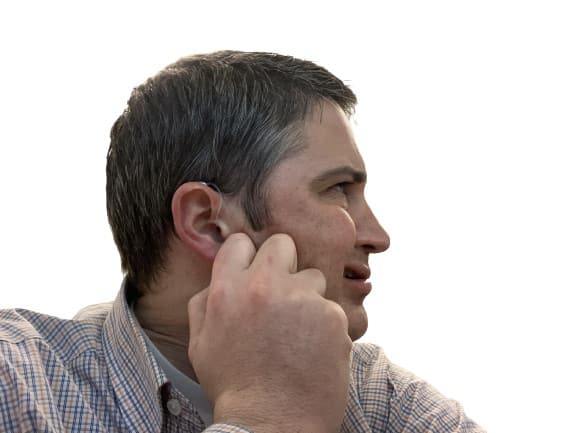As an audiologist who has fitted hearing aids for thousands of patients, I am often asked how long it takes for the brain to adapt to using hearing aids.
- The first 2 weeks are the hardest and patients should expect difficulty
- Most users adjust to a hearing aid after 1month.
- After 4 months you reach full adaptation
It is important to understand that the brain needs time to re-educate and re-acclimate itself to certain sounds, especially after years of hearing loss. By following the steps outlined in this article and being patient with the adjustment process, you can get the most out of your hearing aids and improve your overall quality of life.
The Adjustment Period
Getting hearing aids can be a life-changing experience for those with hearing loss, but it’s important to remember that there is an adjustment period before reaping the full benefits. According to research, it can take up to four months to adjust to wearing hearing aids and get the most out of them. During this period, it’s important to be patient and realistic about the process of adapting to wearing hearing aids.
I assume your hearing aids are set correctly. Your audiologist should have used uses real ear measures to ensure that they are set correctly. Even still it takes time to adapt to prescription settings. If you use OTC hearing aids, it can be harder to know if they are set correctly, but you can fine-tune and adjust them until they are comfortable.
It’s important to remember that hearing loss has likely been gradual but with hearing aids, we try to give all your hearing back all at once. Remember your brain needs time to re-educate and re-acclimate itself to certain sounds. Things should sound tinny, as those are the sound that you have forgotten about.
At first, wearing hearing aids may feel uncomfortable or unnatural, but rest assured that with practice and patience, your perceptions will improve over time. To make the adjustment process smoother, here are some tips for wearing hearing aids at first:
- Wear your hearing aids as much as possible to practice recognizing sound direction and learning which hearing aid settings work best for you in different situations.
- Use the volume control to turn the sound down if it is bothering you.
- Take breaks and rest when necessary, as the adjustment period can be tiring. It is okay to take aids off for an hour or two but please put them back on after.
- Gradually increase wear time, starting with wearing them at home and in quiet environments and then moving on to wearing them in louder and more complex environments.
- Don’t be afraid to reach out for support during the adjustment period, whether it’s from family, friends, or your audiologist.
- If your own voice is bothersome, consider switching dome/earmold.
By following these tips, the adjustment period to wearing hearing aids can be much smoother and less stressful. Remember that your brain will adapt to your new way of listening, and soon enough, your hearing aids will feel like a natural part of your daily routine.
Ask About Auto Acclimization Features in Your Hearing Aids

Most professionally-fit hearing aids have a feature that will start your hearing aids at a softer volume. This is called auto-acclimatization in Phonak aids. Usually, this is about 80% of your prescription. Then every ten hours of use the hearing aids will increase by a small amount.
The aids continue to increase in volume until they reach 100% (or the amount your audiologist has them set to). Typically this process takes between 14 days and 2 months. Your audiologist can set the time length as needed.
The benefit of this feature is you get used to wearing the aids and do not have to return multiple times for follow-up appointments to get the hearing aid settings changed. Almost all manufacturers have a similar feature, just ask your audiologist about it. These features have been shown to increase user satisfaction with their hearing aids.
Getting Used to Hearing Aids
Getting hearing aids is a quick and painless process, but adjusting to wearing them can take time. Just like all things hearing aids have side effects. Ideally, To allow your brain to adapt to your new way of listening, your hearing aids should be kept in all day and only removed while showering or sleeping.
At first, wearing hearing aids may feel strange or uncomfortable, and the sensation of better listening abilities can be overwhelming and possibly cause headaches. However, with time, your brain will learn to rewire itself and re-acclimate to certain sounds.
If full-time use is too much, you can start wearing your hearing aids part-time and gradually work up to wearing them for longer periods throughout the day. This allows your brain to gradually adapt to new sounds and sensations. It may also be helpful to start wearing them at home, to begin with, in a quiet room, and to gradually increase the complexity of the listening environment.
Other tips for getting used to hearing aids include not adjusting the volume too much, using them while watching TV, having a conversation with one person, trying them in a loud setting, and attending follow-up visits with your audiologist. Your audiologist can also help you troubleshoot any issues you may be having with your hearing aids and provide additional support, counseling, and guidance during the adjustment period.
Is it Worth The Hassel?
I can personally tell you it is very much worth the hassle of adjusting to hearing aids. It will improve your life. But don’t take my word for it, check out what recent research says.
The Journal of Clinical Medicine published a study investigating the link between hearing aid use and cognitive decline in older adults. Participants aged 62 to 82 years old were assessed before and 18 months after receiving hearing aids.
After 18 months of wearing hearing aids, there was a significant improvement in speech perception in quiet, self-reported listening disability, and quality of life. Additionally, executive function significantly improved, and there was no significant decline in group mean scores across the cognitive test battery.
These findings are significant because they suggest that treating hearing loss with hearing aids may delay cognitive decline. This is particularly important for older adults who are at higher risk of cognitive decline and may benefit from the use of hearing aids. By improving speech perception, quality of life, and executive function, hearing aids can help older adults maintain their cognitive abilities and independence.
Conclusion
In conclusion, adjusting to hearing aids can take time, but with patience, commitment, and support, it is possible to achieve hearing success. It’s important to start by wearing hearing aids as much as possible and gradually increase wear time to get used to the sensation of better listening abilities. If you do not like your hearing aids, exchange them in the trial period (usually the first 45 business days), and try a different style. Learn more about cleaning and maintenance to get the most benefit from your hearing aids.
If you or a loved one are struggling with hearing loss, it’s important to seek out professional help and consider the benefits of using hearing aids. Remember that the brain needs time to re-educate and re-acclimate itself to certain sounds, and a positive attitude and realistic expectations are key to success. With practice and patience, your perceptions will improve over time, and you can enjoy the benefits of better hearing.

